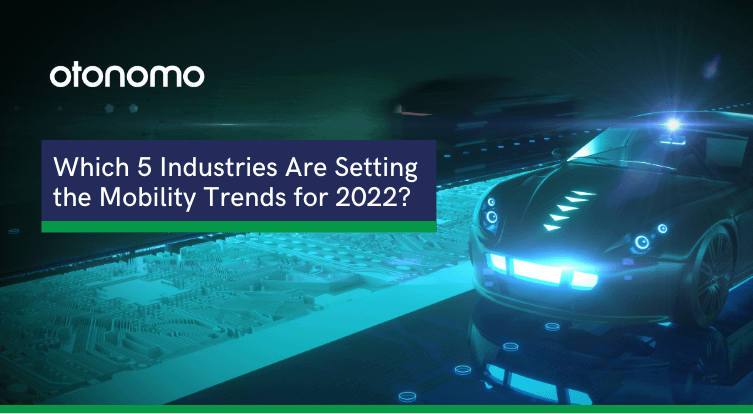As 2021 is drawing to a close, and we start gearing up (#sorrynotsorry) to 2022, the mobility space keeps evolving at an incredible pace around us. Technology will keep marching forward, with autonomous, connected, and EV gaining more ground, and smart cities continuing to expand and improve their services. Legislation and regulations will limit autonomous vehicle adoption. Yet, it will drive new growth in EV vehicle adoption in an attempt to reach carbon emissions goals. The drive for EV growth, however, may be limited by supply chain failures and continued chip shortages.
Smart cities will continue to combat congestion by expanding multi-modal mobility options, especially MaaS and micro-mobility, and utilizing tactical urbanism for low cost, high impact testing of new ideas and implementation of new policies.
Fleets are going to continue their digital transformation, not only to increase productivity but also as a countermeasure to growing costs and a more complex urban environment. Covid-19 will continue to dominate every trend in 2022, limiting the demand for vehicle concierge services and increasing demand for last-mile delivery solutions.
Last but not least, adjacent industries, like insurance, mapping, construction, and more are going to continue discovering the enormous potential of connected vehicle data and expand the market for it.
Government push for Electric Vehicles drives infrastructure expansion and lowers costs
Government support for transportation electrification has gained significant momentum in recent years, and in the aftermath of the 2021 climate conference in Glasgow, policymakers are doubling down on playing a pivotal role in state efforts to transform the transportation sector. In the US, at least 47 states offer incentives to support the deployment of EVs and most European countries offer at least an exemption from road tax for electric vehicles.
Countries do not only offer tax rebates, bonus payments, or premiums to buyers of EVs, they are also subsidizing and supporting the creation of infrastructure through direct investments. Especially when it comes to charging stations that require zoning and other permits. Charging remains an issue though, and according to some, 1 in 5 electric vehicle owners switched back to gas because of the hassle around it.
Yet, despite this minor setback, price drops, and a genuine interest means Electric Vehicle (EV) sales were set to hit 5.6 million in 2021 and will continue to grow in 2022. Tesla is still the number one seller of EV’s but Chinese manufacturers are becoming more and more dominant; providing 12 out of the 20 top selling models. And while early EV adoption was driven by incentives and rewards, we’re going to see improved battery technology and better infrastructure make these policies increasingly unnecessary.
There are some roadblocks, however. The battery market is currently controlled by China that produces about 70% of batteries, and the shift for hydrogen fuel cells or other technology still some time in the future, supply chain threats could limit production capabilities and demand may not be met. On the charging front, the blitz to meet quotas may mean companies deploy charging stations without proper mobility intelligence analysis, and that may result in some costly mistakes.
Increased Costs for Fleet Management mean more focus on data as a countermeasure
The automotive sector has been hit particularly hard by the semiconductor chip shortage, and experts are predicting this will continue into 2023, at least to a certain extent. Fleets are especially hard hit and are unable to buy the quantity of vehicles they are planning for. Shortages led to rising prices that hike costs above expectations.
Yet, in spite of the challenge to the procurement process, the high volatility of oil prices, coupled with the pressure and incentives from the government, is set to drive EV adoptions among fleets. This in turn means 2022 will see many of the existing practices and solutions employed by FMS updated and revamped – including fueling solutions, replacing obsolete OBD for a fully connected vehicle, and more.
Procurement challenges also mean fleets need to hold onto existing vehicles longer and are expected to incur higher maintenance costs. Solutions such as predictive preemptive maintenance and remote telemetries are set to become critical rather than nice to have options for fleet managers to combat rising costs and to remain competitive.
2022 looks like it is set to challenge many fleet managers, but the market seems ready for the transition to take place. Fleet managers needing to support longer vehicle life cycles are expecting more data and are better equipped to use it, and they are demanding more OEM data and better more robust APIs to meet demand.
The solutions are already in place. Start using the data underneath the hood to get ahead of fleet maintenance and reduce the costs of keeping vehicles on the road.
OEM’s making big software plays and connected vehicles get even more connected
2021 saw many car manufacturers doubling down on their software investments and making big bets on connectivity and on software platforms. The prediction that by 2025 all new vehicles will be connected seems to still hold true. Stellantis announced the deployment of a next-generation platform based on an open software architecture they expect will generate €20 billion in incremental annual revenues by 2030. And General Motors is set to roll out Ultifi, a new end-to-end software platform in 2023.
This software drive is aimed mainly at creating an in-vehicle user experience, enabled by advanced consumer electronics and Human-Machine Interface (HMI). It seems like the OEMs are hoping they can translate this new software-centric approach into their own applications and services marketplace, which will not only generate revenue directly but also help in customer retention and loyalty.
But this commitment to software and connectivity goes beyond empowering apps and services, OTA software updates, or better in-car entertainment systems. Better and deeper connectivity enables the creation of an entire mobility ecosystem that incorporates vehicles with MaaS and city services as well as many other advanced use cases. More and more cars being connected opens the market to more and more new opportunities.
Coupled with the growth of OEM software platforms, smart adaptive edge/cloud orchestration is also set to improve in 2022 meaning that vehicle data can provide better near-real time information alongside critical planning data. The rise of proprietary software systems will also mean that anyone needing to acquire data from more than one source will need to either spend resources on complicated integrations and business and legal relationships or utilize platforms that enable access to a wide range of makes.
According to McKinsey, “Connected cars are poised to become potent information platforms that not only provide better experiences for drivers but also open new avenues for businesses to create value.”
Looking further into the future it seems like video telemetry, and the advancement it brings to driver safety will be the next big thing in terms of car sensors. Now available mainly as a fleet add-on solution, OEMs will embed video telemetric hardware solutions in more and more vehicles.

Smart Cities getting smarter with vehicle data, and more service-oriented with MaaS
There’s no doubt that smart cities will continue to grow in 2022, with municipalities and governments all over the world looking to speed up connectivity and efficiency in the way they run public transport and mobility for their residents and visitors.
Mobility-as-a-Service will be a buzzword for 2022, with more cities looking to offer shared mobility services such as scooters and rideshare apps and services, or even just improved and enhanced buses, trains, trams, and bikes. These support sustainability initiatives, plus serve the millennial audience who are today’s most frequent commuters. As usage grows, mobility intelligence becomes critical for optimized usage and deployment as well as for enabling service expansion.
Aside from MaaS solutions, however, as data becomes more and more prevalent it is also becoming more and more important to be able to process this data into actionable insights by using urban intelligence, integrating multi-layered vehicle data to generate hazard data, traffic efficiency, and management, toll collection, parking allocation, control dynamic signage and much more.
Cities will continue to migrate away from obsolete measurement methodologies and towards relying on multi-layered vehicle data to gain a better understanding of what is happening in them.
The Crawl to Autonomous Vehicles continues but slowly
And talking about autonomous vehicles…. You might be bored of hearing people say “this is the year autonomous vehicles find their feet”, so we won’t say that. But in 2022 the industry is planning some landmark achievements. In China, AutoX is now offering driverless taxi rides, and in Germany, driverless services have been given the green light for 2022 in specific areas, and in the US General Motors’ Cruise targets 2022 for driverless taxi services – running with a 30 mps speed limit and only at night.
The technology driving this growth is in large part an improvement in sensing technologies. Radars are getting better at their role, Tesla is trialing camera-only solutions, and the costs of LIDAR are falling lower than ever before.
If 2022 is the year you’re putting your mobility-related use case into action, you’re going to need to start with data! Get in touch to see a demo of the Otonomo platform your one-stop shop for connected vehicle data in all shapes and sizes.









